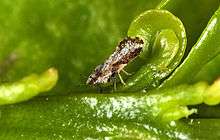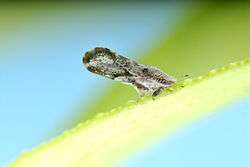Diaphorina citri
Diaphorina citri, the Asian citrus psyllid, is a sap-sucking, hemipteran bug in the family Liviidae. It is one of two confirmed vectors of citrus greening disease.[1][2] It has a wide distribution in southern Asia and has spread to other citrus growing regions.
| Diaphorina citri | |
|---|---|
 | |
| Asian citrus psyllid, Diaphorina citri | |
| Scientific classification | |
| Kingdom: | Animalia |
| Phylum: | Arthropoda |
| Class: | Insecta |
| Order: | Hemiptera |
| Suborder: | Sternorrhyncha |
| Family: | Liviidae |
| Genus: | Diaphorina |
| Species: | D. citri |
| Binomial name | |
| Diaphorina citri Kuwayama, 1908 | |
Distribution
The Asian citrus psyllid originated in Asia but it is now also found in parts of the Middle East, South and Central America, Mexico, and the Caribbean. In the United States, the psyllid was first detected in Florida in 1998 and is now also found in Louisiana, Georgia, Arizona, South Carolina, and Texas .[1] In Southern California, the San Joaquin Valley, and Central Coast counties, such as San Luis Obispo, an eradication program has been instituted in an attempt to prevent it from becoming established.[3][4] In the whole of the United States and its territories, areas where this psyllid are found are under quarantine restrictions.[5]
Description

The adult psyllid is about four millimetres long with a fawn and brown mottled body and a light brown head. It is covered with a whitish, waxy secretion which makes it look dusty. The forewings are broadest at the back and have a dark edging around the periphery with a pale gap near the apex. The antennae are pale brown with black tips. These features distinguish it from the superficially similar African citrus psyllid. It typically adopts a head down, tail up posture as it sucks sap. Aphids are often also present on citrus and psyllids can be distinguished from them by being more active, jumping insects, whereas aphids are sedentary. In addition, the antennae of a psyllid has ten segments whereas those of aphids usually have four or six segments. Most aphids have cornicles on the abdomen and psyllids lack these.[1]
The psyllid nymph moults five times. It is a yellowish-orange color and has no abdominal spots. The wing pads are prominent, especially in the later instars.[1]
The eggs are approximately 0.3 millimeters long, almond-shaped, thicker at the base and tapering toward the top. They are at first a pale color but turn yellow and later orange before they hatch. The long axis is placed vertical to the surface of the leaf.[1]
Life cycle
Eggs are laid on the tips of growing shoots, between and near the unfolding leaves. A female may lay up to 800 eggs during her lifetime which may be several months. The whole development cycle takes from two to seven weeks depending on the temperature and the time of year.[6]
Predation
The wasps Brachygastra mellifica and Tamarixia radiata are a common parasitoids of D. citri.[7] Lady beetles are also important predators.
Damage
Psyllid nymphs are found on new shoots of citrus trees. As they feed, they produce a toxin that causes the plant tips to die back or become contorted, preventing the leaves from expanding normally.[3] However, direct damage from feeding by the psyllid is considered minor compared with the role the psyllid plays as the only known nonhuman vector of citrus greening disease.
Citrus greening disease
Feeding can vector bacteria that causes one of the most devastating of citrus diseases, citrus greening disease. Affected trees bear small, asymmetrical fruit which are partially green and which are unsellable because of their poor size and quality.[3]
Control
The Asian citrus psyllid has a number of natural enemies including hoverflies, lacewings, several species of ladybird and a number of species of parasitic wasp.[8] One of these wasps, Tamarixia radiata, has proved very effective at controlling the pest and has been successfully released and become established in a number of citrus growing areas including Florida.[9][10] Both adults and nymphs of the psyllid can be controlled by the use of a wide range of insecticides.[11] Citrus greening disease is best controlled through an integrated strategy involving the use of healthy planting material, the control of vectors, and the prompt removal of infected trees and branches.[12]
Recent efforts have focussed on understanding the various sensory cues that the psyllid uses to locate its host plant. Insight into the insect's behavior may lead to better methods for its control. One study demonstrated that perception of reflected ultraviolet wavelengths enhanced attraction to a yellow trap.[13] Attempts to demonstrate attraction of the psyllid to volatile (air-borne) odors have failed to produce an effective attractant.[14] It appears that this tiny insect is attracted by color (yellow and UV wavelengths) and decides to stay and feed on a particular plant only after alighting on a leaf and tasting it by probing with its mouthparts (stylets). Small molecules such as formic acid and acetic acid stimulate probing activity.[15] These may be used in new, innovative traps or other devices.
References
- "Asian citrus psyllid - Diaphorina citri Kuwayama". entnemdept.ufl.edu. Retrieved 3 April 2020.
- Lallemand, J., A. Fos, and J. M. Bové. 1986. Transmission de la bacterie associé à la forme africaine de la maladie du "greening" par le psylle asiatique Diaphorina citri Kuwayama. Fruits 41: 341-343.
- Center for Invasive Species Research
- Citrus Blight Triggers Alarm; California Confronts Incurable, Insect-Borne Tree-Killer That Makes Fruit Bitter April 15, 2012
- "Citrus Greening Regulatory Updates". USDA APHIS. Archived from the original on 21 March 2010.
- Husain MA, Nath D. 1927. The citrus psylla (Diaphorina citri, Kuw.) (Psyllidae: Homoptera) Memoirs of the Department of Agriculture India 10: 1-27.
- Reyes-Rosas, Marco Antonio (2013). "Brachygastra mellifica (Hymenoptera: Vespidae): Feeding Behavior and Preferential Predation on Diaphorina citri (Hempitera: Liviidae) Life Stages in México". Florida Entomologist. 96 (4): 1588–1594. doi:10.1653/024.096.0443.
- Waterston J. 1922. On the chalcidoid parasites of psyllids (Hemiptera, Homoptera). Bulletin of Entomological Research 13: 41-58.
- Hoy MA, Nguyen R. 2001. Classical biological control of Asian citrus psylla. Citrus Industry 81: 48-50.
- Asian citrus psyllid biological control release program. Beltsville, MD: United States Department of Agriculture, Animal and Plant Health Inspection Service, Plant Protection and Quarantine. November 2019. Retrieved 6 February 2020.
- Bindra, OS; Sohi, BS; Batra, RC (1974). "Note on the comparative efficacy of some contact and systemic insecticides for the control of citrus psylla in Punjab". Indian Journal of Agricultural Science. 43: 1087–1088.
- Korsten, L. (2004). "Citrus Huanglongbing: Review, Present status and Future Strategies". Diseases of Fruits and Vegetables Volume I: 229–245. doi:10.1007/1-4020-2606-4_4. ISBN 978-1-4020-1822-0.
- George, J., T.M. Paris, S.A. Allan, S.L. Lapointe and L.L. Stelinski. 2020. UV reflective properties of magnesium oxide and barium sulfate increase the attraction and probing behavior by Asian citrus psyllids (Hemiptera: Liviidae). Scientific Reports 10, 1890. https://doi.org/10.1038/s41598-020-58593-4
- George, J., P.S. Robbins, R.T. Alessandro, L.L. Stelinski and S.L. Lapointe. 2016. Formic and acetic acids in degradation products of plant volatiles elicit olfactory and behavioral responses from an insect vector of a major plant pathogen. Chemical Senses 41(4):325-338
- George, J., D.G. Hall, S.L. Lapointe. 2016. A phagostimulant blend for the Asian citrus psyllid. Journal of Chemical Ecology 42(9):941-951
External links
- Species Profile-Asian Citrus Psyllid (Diaphorina citri), National Invasive Species Information Center, United States National Agricultural Library. Lists general information and resources for Asian Citrus Psyllid.
- Featured Creature: Diaphorina citri; University of Florida article on the biology of the organism.